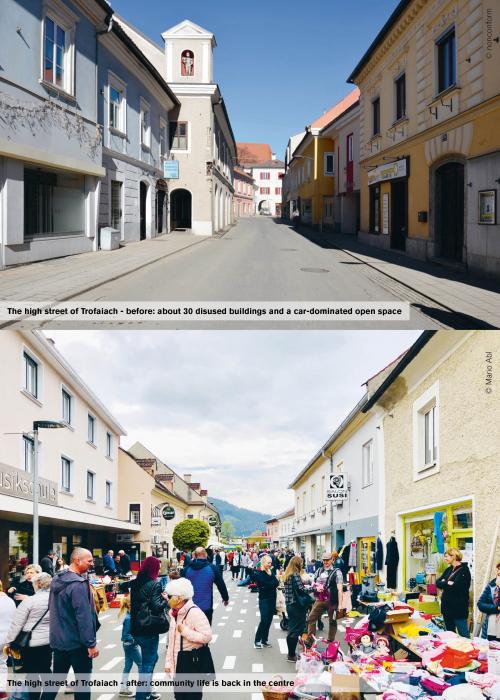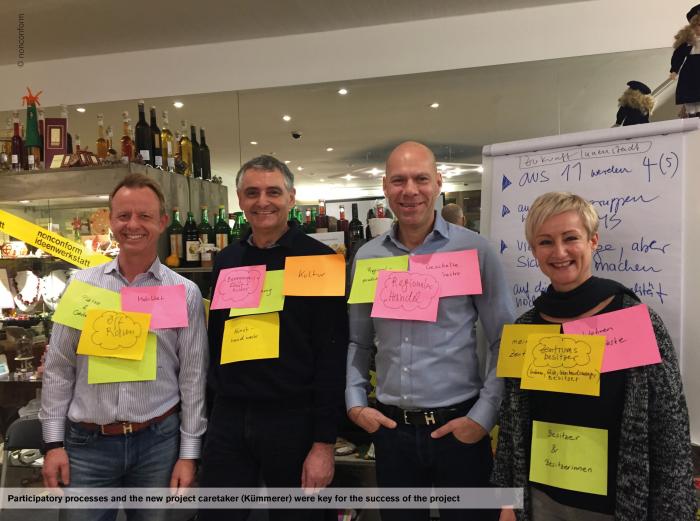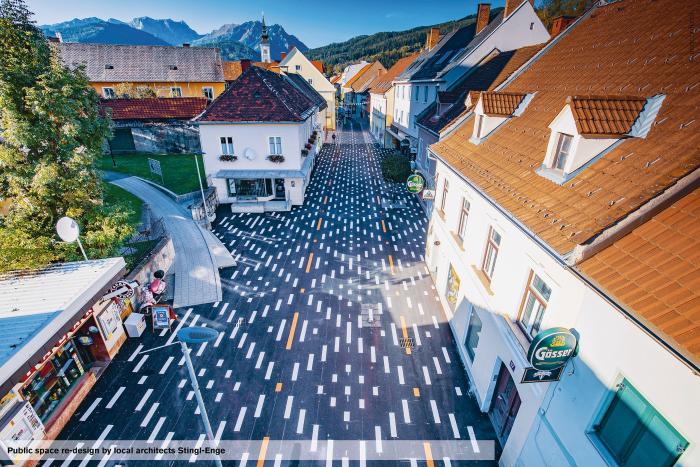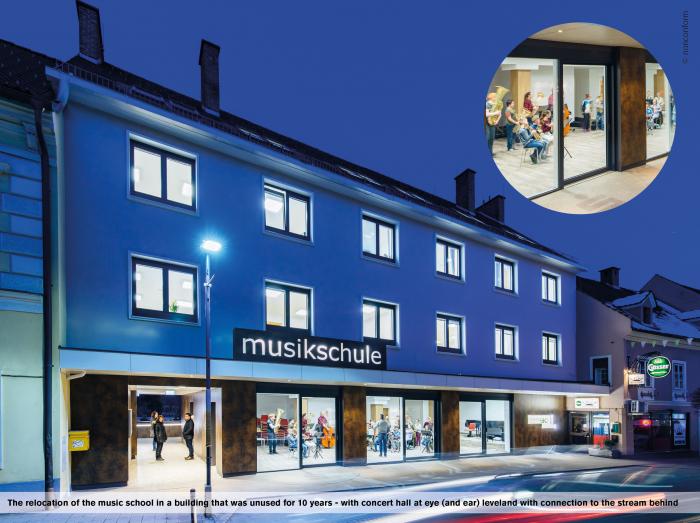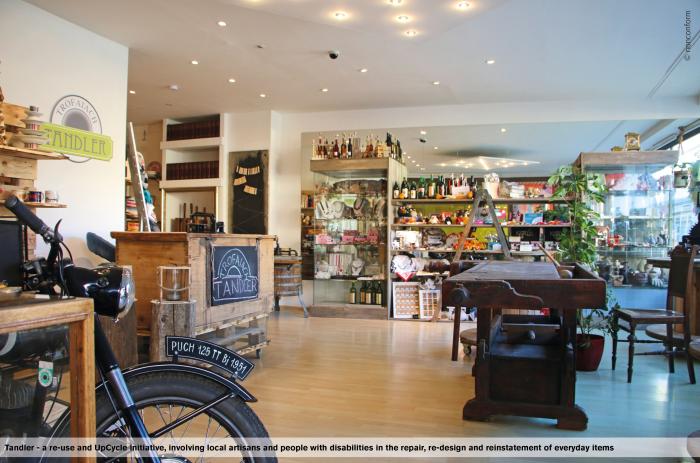I. SUMMARY INFORMATION
Project
269764
Status
Submitted
Award category
Reinvented places to meet and share
You want to submit
NEW EUROPEAN BAUHAUS AWARDS : existing completed examples
Project title
My heart is where my centre is
Full project title
From Donut to Krapfen - the case of Trofaiach
Description
Young people moving out of small towns? Car-dependent old people isolated in the periphery? Expensive yet disused historic buildings? Deserted unattractive streets? Welcome to the Donut-effect. With nonconform, a participatory planning and design practice, the town of Trofaiach fought this with an inclusive method of dialogue and co-creation. Now most abandoned buildings are back in use, streets attract visitors of all ages, on public transport and leaving cars behind. The centre lives again.
Where was your project implemented in the EU?
Austria
Styria
Luchinettigasse 9
47°25'34.3"N
15°00'32.6"E
Trofaiach
8793
When was your project implemented?
Has your project benefited from EU programmes or funds?
No
Which programme(s) or fund(s)? Provide the name of the programme(s)/fund(s), the strand/action line as relevant and the year.
II. DESCRIPTION OF THE PROJECT
Please provide a summary of your project
In 2015 Trofaiach was only one of many small European towns affected by the Donut-effect leading to deserted historical centres: urban sprawl, peripheric shops re-location, a car-dependent lifestyle and migration to bigger cities. It faced the economic challenge of many disused old buildings and the existential question of how to attract future generations.
Despite a Development Framework setting a clear position against this, not much was happening. When the last bank moved out of the centre the administration changed approach and appointed nonconform as a process designer and facilitator with extensive expertise, to ´lead by accompanying´ it towards the definition and implementation of an alternative strategy.
First, to create motivation, the administration visited three similar successful examples. A nonconform ideenwerkstatt followed. This is a participatory process where the community, stakeholders and local experts explore ideas, agree a vision and identify short- and long-term measures of implementation. Various events were then organized turning the main street into a meeting/celebration space to make this vision and its qualities tangible to all concerned - and maintain momentum towards its implementation. Implementation was also holistic, involving the local administration, politicians, the community at large and any player that could influence specific decisions and initiatives. A key role was played by the “Kümmerer”, coached and assisted by nonconform. This newly defined full-time position activates at all steps the right persons in the complex network of actors involved, keeps the process open and inclusive, makes the necessary information and expertise accessible, and ensures that all that is required to achieve the masterplan gets done.
Today Trofaiach is a best practice example in urban strategies for a future that is environmentally, socially and economically sustainable. It has its future in its own hands and its heart back in place:the centre
Please give information about the key objectives of your project in terms of sustainability and how these have been met
A main objective was an environmental, economic and social sustainable development. This was achieved by:
adopting a holistic participatory approach to address these dimensions in their complexity and interdependence, make implementation possible and ensure that solutions are integrated in the life of the town
facilitating through the iterative participatory process a higher identification with the community and the outcome, sense of belonging and social cohesion
focusing the development inside the town boundaries
refurbishing existing buildings, avoiding demolition as far as possible
redefining the high street in light of specific local needs and future trends: from a past focused on commerce and gastronomy to a diverse future, based also on other services, community and locality
finding new uses and operators through participation, which therefore are more relevant to the community and have better chances to succeed
making the centre a meeting place again and integrating it in the everyday life, facilitating social cohesion and an increased sense of well-being and quality of life
ensuring pedestrians have priority in front of cars by re-designing the public space (shared surface, 20km/h for cars and urban furniture produced by locals)
ensuring an active street front with ground floor uses that extend into the public space
encouraging sustainable behaviours by creating a mobility interexchange point at the edge of the centre with bus station, cycling racks and E-charging station and increasing the frequency of the bus service
The final proof for sustainability is in continuity: having developed the tools, Trofaiach is now addressing the next points on its agenda. A programme involving property owners aims to activate existing buildings to diversify the housing offer. Through the reintegration of the disused railway area into the urban fabric, and a mixed-use development is on its way with high quality green spaces connecting the various town parts
Please give information about the key objectives of your project in terms of aesthetics and quality of experience beyond functionality and how these have been met
The main objective in terms of aesthetics and quality of experience was to improve the attractivity of the centre for people and visitors of all ages (children, teenagers, adults and older people) and to turn it into a lively place, where people would be happy to spend time in.
This was achieved through the materiality and qualities of the re-designed public space, new uses and shopfronts. For example, the music school accommodates its concert hall on the ground floor in a space that is visible and can open to the street. Moreover, an access to the stream behind is made possible through the building, bringing this forgotten natural element from the backstage in focus.
In a world where shopping is one-click away, the centre remains an important place for live experiences, social encounters and community events. As a meeting place for the community, through vivid experiences and the possibility to actively take part in shaping the common future, the centre gains back its role as place where the local identity is negotiated and expressed.
Anchoring the process in the community and building on existing resources full of character, ensured the continuity of the local identity and an aesthetic with which people identify.
The centre of Trofaiach is not anymore associated to deserted spaces - neither is it (again) with shopping only. The high street is bridging the past and the future through tangible experiences: it is a place to slow down and enjoy the occasional encounter, to share a laugh and participate, to linger in the sun while listening to the sound of music coming out of the school’s windows. It is a place for the community – a place to be.
Please give information about the key objectives of your project in terms of inclusion and how these have been met
Inclusion was from the start at the heart of the project. The participatory approach was open to the whole community and all voices could be heard and contribute by expressing their specific needs to the project. The organized events, such as the nonconform ideenwerkstatt, and action groups were complemented by the continuous presence of the Kümmerer office on the high street.
This openness radiated further in the next stages. For example, through strategies aiming to make the place attractive and accessible for underrepresented categories, such as young people and families, by offering new jobs and logistic and financial support for future oriented small local businesses (StadtUp Programme) – as well as by striving to create alternative and affordable living accommodation close to the centre, that would complement the omnipresent family house and respond to the diverse needs of today’s society.
Accessibility is also achieved in the design of the wheelchair friendly public space and in offering alternative modes of transport. Some of the individual initiatives, such as Tandler, where people with disabilities and refugees are involved in the repair, re-design and reinstatement of everyday items followed the principles of inclusion and transformed them in everyday reality.
Please give information on the results/impacts achieved by your project in relation to the category you apply for
The impact of the process is multifaceted, spreading for example from the macro level of the local administration way of dealing with future regeneration projects, up to the individual level of the citizen, who has an increased sense of empowerment, of belonging and quality of life.
A few of the mentioned categories are here exemplified:
Impact on disused buildings
Today, as many as two thirds of Trofaiach’s disused buildings have found new functions: new businesses and initiatives, Start-Ups and temporary uses, various specialized shops. Among them is the “Trofaiach Tandler” – with a focus on upcycle and re-use of everyday items. A music school with 360 pupils is now spanning on the four floors of a building that was unused for over 10 years. Due to the increased flow of potential customers, the old abandoned local Pub attracted a new operator and re-opened its doors. A shop selling timber made bicycles, one for outdoor equipment, and a yoga studio recently opened.
Impact on public space use
The public space in the centre is alive again. The shared surface, on a project by local architects Stingl-Enge, makes the human scale central and reintegrates this space formerly dominated by cars into the everyday life. Temporary events and activities take place such as outdoor concerts or summer evening cinemas, markets and celebrations, and the yearly community festival.
Impact on transport
As a result of improving the public transport service and placing a focus in alternative means such as cycling, a shift away from the omnipresent car was created. Now people can and do use public transport to come to the centre or to travel to the neighbouring towns.
Because these and other new uses emerged from the participatory process and local initiatives, they are highly relevant to the community – and therefore welcome and successful.
Please explain the way citizens benefiting from or affected by the project and civil society have been involved in the project and what has been the impact of this involvement on the project
The participatory process was the backbone that bound the many aspects of the project together and paved the way to its implementation by ensuring that behind initiatives and frameworks were always concrete measures and people that owned them.
The nonconform ideenwerkstatt brought together over 1.000 people working intensively for 3 days and producing over 800 ideas for the regeneration of the centre. From older generations to children, as well as politicians, civil servants, professionals and businesses, each brought their expertise and knowledge of the place to define a common vision for its future.
Ideas were collected through Ideenboxen, distributed in town or were directly received on the spot, in the temporary nonconform open office. During workshops and evening events themes were identified and discussed. The outcomes were presented in a festive atmosphere on the last day and recorded in a report and masterplan to inform the long-term process.
Different agents’ constellations were afterwards activated by the project caretaker (Kümmerer) to define and make the necessary steps for its implementation. Still, specialized work groups met and discussed further main issues, such as public space and new uses, and specific stakeholders working sessions took place for specific relevant decisions. Furthermore, opening the office of the Kümmerer in a disused space on the high street, where new contributions and ideas were always welcome, acted as a catalysator and ensured a continuous dialogue with the community.
The impact of this exhaustive involvement was not only that the solutions identified fulfilled the specific needs of the people but also that people could identify with them and take active care in their implementation. Their sense of agency was increased and the loop between politics and citizens closed, ensuring the success of the project. Indeed, by creating a sense of ownership, initiatives were taken over and developed further with a snowballing effect
Please highlight the innovative character of the project
The Donut-effect is a common reality of many small European towns. Even though the measures against it are known in theory, the implementation often stumbles into divergent interests and power structures. Trofaiach shows that when creating momentum and turning the divergent forces into convergent energy flows, a lot becomes possible.
The innovative character lays exactly in the same place as its secret to success: in its holistic approach which sees boundaries as an opportunity to connect and evades the usual, expert-led sectional thinking. Thorough, real participation achieved with the nonconform ideenwerkstatt and the following Kümmerer initiatives, as well as short-term measures (such as reconfiguring Rossmarkt, a central street into a pedestrian area, the design and production of urban furniture with the involvement of the locals, etc.) ensured that momentum was not only created but also appropriately channeled from the bottom upwards.
The new position of the Kümmerer was defined, further refined throughout the project and also officialized: a networking event of persons with similar profile was initiated and is taking place regularly. The Kümmerer is the indispensable motor that such long term developments need.
Please explain how the project led to results or learnings which could be transferred to other interested parties
With this and similar projects nonconform has developed an approach that is structured to achieve exhaustive and in-depth participation to the solution of an all-too-common problem: the progressive abandonment of small-town centers and the ensuing social, economic and sustainability issues.
Going against this flow and fighting on, in a process expected to last for more than ten years needs courage, strength and a lot of energy. A clear and consistent position on the side of politics and administration is needed to redirect development inside the town boundaries. However, top-down processes alone are not only financially challenging but also unlikely to produce realities that people will identify with and appropriate.
A common vision defined through co-creation community participatory processes and an overarching framework or masterplan to set the pace and keep goals in sight are just as essential, as the people that are behind them. The Kümmerer is key for the continuity of the project beyond the political tact of elections, for activating the right people and networks for each initiative at the right time and for keeping the process alive and open to involvement and new opportunities.
The specific participatory method and formats used in Trofaiach, the active involvement of the local administration as catalysator for change, the empowerment of the local community, the definition of the role of project Kümmerer, are all aspects that are easily transferrable to other interested parties.
Last but not least, direct positive shared experiences and celebrations which inspire, re-affirm the common principles and bring joy are essential for making the process tangible and for giving an energy boost to the sustained effort that such complex processes require.
Is an evaluation report or any relevant independent evaluation source available?
No
III. UPLOAD PICTURES
IV. VALIDATION
By ticking this box, you declare that all the information provided in this form is factually correct, that the proposed project has not been proposed for the Awards more than once under the same category and that it has not been subject to any type of investigation, which could lead to a financial correction because of irregularities or fraud.
Yes
